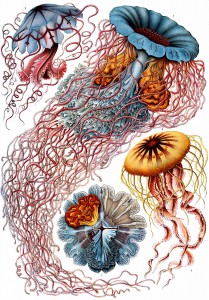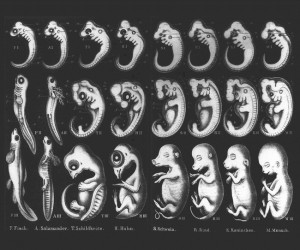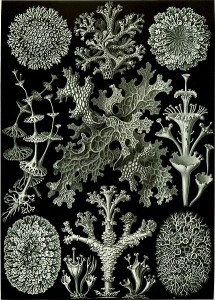A Romantic, Maybe too Romantic, Scientist
In the Hatena story about symbiosis, I posted the following picture drawn by Ernst Haeckel:
Beautiful! In this day and age of imaging, high resolution photography, and molecular graphics, we forget that scientific drawing was a skill as necessary to life scientists as microscopic imaging, or molecular graphics is today. Indeed, biology was very much a descriptive discipline in the 19th century, and being able to articulate your findings –in words as well as in art — was as valuable a skill as the ability to posit a hypothesis and then design an experiment to test it. Possibly even more valuable in some circles. Scientists won medals and were awarded promotions based on their drawing skills. A naturalist’s drawings could not be inaccurate, nor could the images be occluded or embellished, they had to be very precise. But that does not mean that there was no room for artistic input. Those could be found in the hues, the lighting, the composition, point of view angles and arrangement of the subjects drawn. Haeckel definitely had his distinctive style: part Romantic, with a Gothic undercurrent. In Art Forms of Nature he would take a series of subjects in the same genus, and arrange them in the contemporary style tessellated form, like this (all pictures are from Wikimedia Commons and are in the public domain):
no images were found
Darwin himself was so impressed by Haeckel’s drawings that he wrote they were “..the most magnificent works which I have ever seen, & I am proud to possess a copy from the author“. Haeckel himself was a staunch supporter of evolution by natural selection, and held Darwin in great esteem. It very brave stand taken by a young assistant professor in Jena in Germany at a time when evolution itself was already quite accepted in many scientific circles, but Darwin’s theory of natural selection was still hotly debated. Haeckel served to popularize evolution, and his popular lecture series in Jena attracted hundreds of listeners. His beautiful drawings serve as a frontispiece to his scientific writings, serving not only to illustrate, but to attract his readers.
His was a troubled soul. The love of his life, Anna Sethe Haeckel died of a sudden illness at a young age. He remarried, but never recovered from his broken heart, calling Anna the “only true love” of his life. While being a popular advocate of natural selection, he also attracted a lot of ire form his peers and the public. He was strongly opposed to any form of organized religion, even more so following his personal tragedy. His was the religion of Spinoza and Goethe — that of monism. Unlike Darwin, Haeckel zealously recruited Evolution to a cultural fight, and has caused a massive backlash from established religious circles that is lasting to this very day. He was Romantic, in the sense that he was influenced by such as Goethe and Humboldt, seeking underlying unities in nature and in life, a quest which may have lead him to his greatest — yet false — achievement.

The central medusae are Desmonema annasethe. Haeckel named them after his late wife Anna Sethe. The medusae tentacles reminded him of her "long flowing hair".
Haeckel is best known for formulating the now-rejected Biogenetic Law which states that the embryonic development of an individual organism (its ontogeny) followed the same path as the evolutionary history of its species (its phylogeny). The Biogenetic Law, or Law of Recapitulation (ontogeny recapitulates phylogeny) was in the books until the late 20th century. Although it is pretty clear that the phases an embryo goes through do not match the species history, it is still an idea that is circulating in popular culture and pseudo-scientific circles. Haeckel was accused at his time and later of forging the famous embryo sketches, an accusation that, if it weren’t for the support of Darwin and other prominent scientists of his time, would probably have caused him to lose his job. The forgery vs. overzealous interpretation debate continues to this very day, and unfortunately serves in very a warped interpretation as an argument against evolution. The creationist reasoning goes something like: “Haeckel lied –> the law of recapitulation is founded on a fraud –> all evolution is a fraud”. Not a very smart argument, since recapitulation was never a pillar of natural selection.
In 1997 Michael Richardson and colleagues published an article titled: “There is no highly conserved embryonic stage in the vertebrates: implications for current theories of evolution and development”. In the article, they compared photographs of embryos to Haeckel’s illustrations, and found gross discrepancies, which they interpreted as probable fraud.The other side of the story is that Richardson et. al left the yolk sacs in, (Haeckel removed them) and compared their photos to a derivative work rather that Haeckel’s drawings where the embryos are actually quite different from each other. In 2002 they published another paper, where they explored Haeckel’s ideas as well as his drawings, and concluded that although deeply flawed, it is hard to show fraud especially since Haeckel himself was not the strict recapitulationist that his later followers were.

Haeckel, E. 1874. Anthropogenie: Keimes- und Stammes-Geschichte des Menschen; From left to right: fish, salamander, turtle, chicken, pig, cow, rabbit, human. The uppermost row of illustrations represents a conserved stage across Vertebrata
I’m not getting into this discussion, really, which sometime seems like a 150 year old flame war on fark.com (Let’s see if this link gets my blog farked, hehe). My take is that an amazing artist and naturalist such as Haeckel was seeing from his own heart’s desire, but so were a lot of other embryologists, way down to my biology teacher in high school. (I dropped the developmental biology course in college, something I regret now, so I don’t’ know what went on there). The seduction of an all-encompassing elegant theory explaining embryonic development has caused many to go, in some form or another, for the Biogenetic Law.
Man, but his drawings are amazing. I can’t wait for my mail order of Art Forms of Nature to come in. and I wonder how Haeckel, if he had lived today, would have injected from his artistic talent into macromolecular drawings such as this:

Illustration of aquaporin, a membrane molecule that controls the flow of water to the cell. The central mesh in A and B shows the water flow. ischer G, Kosinska-Eriksson U, Aponte-Santamaría C, Palmgren M, Geijer C, et al. 2009 Crystal Structure of a Yeast Aquaporin at 1.15 Å Reveals a Novel Gating Mechanism. PLoS Biol 7(6): e1000130. doi:10.1371/journal.pbio.1000130
Update: Art forms of Nature in PDF and HTML is available here.
There is no highly conserved embryonic stage in the vertebrates: implications for current theories of evolution and development
Richardson, M., Hanken, J., Gooneratne, M., Pieau, C., Raynaud, A., Selwood, L., & Wright, G. (1997). There is no highly conserved embryonic stage in the vertebrates: implications for current theories of evolution and development Anatomy and Embryology, 196 (2), 91-106 DOI: 10.1007/s004290050082
RICHARDSON, M., & KEUCK, G. (2002). Haeckel’s ABC of evolution and development Biological Reviews of the Cambridge Philosophical Society, 77 (4), 495-528 DOI: 10.1017/S1464793102005948
Robert J. Richards (2008). The Tragic Sense of Life
Ernst Haeckl Kunstformen der Natur (in HTML and PDF format, German).




















Iddo,
These illurstrations reminded me of the book “Parallel Botany” published a few years back where the author (Leo Lionni) had drawn imaginary plants and written their descriptions.
Cheers,
Thanks. I wasn’t aware of this particular Leo Lionni book, maybe because it is not strictly a children’s book. (My kids loved LL when they were younger). He probably emulated 19th century naturalists in creating his imaginary flora. I’ll definitely check this out.
Very good post. Haeckl was the master in every sense of the word. I think labeling him a fraud would be equivalent to blasphemy in science 🙂